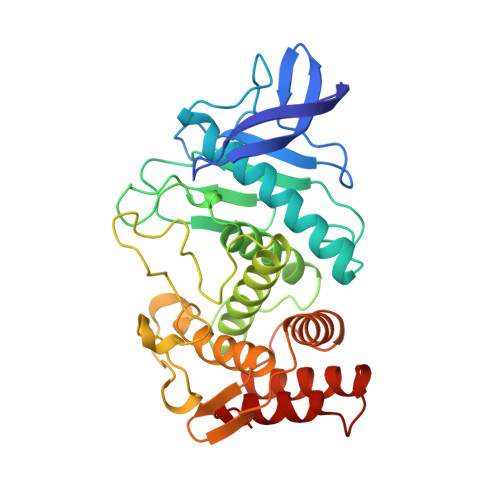Crystal structures of alpha-mercaptoacyldipeptides in the thermolysin active site: structural parameters for a Zn monodentation or bidentation in metalloendopeptidases.
Gaucher, J.F., Selkti, M., Tiraboschi, G., Prange, T., Roques, B.P., Tomas, A., Fournie-Zaluski, M.C.(1999) Biochemistry 38: 12569-12576
- PubMed: 10504225
- DOI: https://doi.org/10.1021/bi991043z
- Primary Citation of Related Structures:
1QF0, 1QF1, 1QF2 - PubMed Abstract:
Three alpha-mercaptoacyldipeptides differing essentially in the size of their C-terminal residues have been crystallized in the thermolysin active site. A new mode of binding was observed for 3 [HS-CH(CH(2)Ph)CO-Phe-Tyr] and 4 [HS-CH((CH(2))(4)CH(3))CO-Phe-Ala], in which the mercaptoacyl moieties act as bidentates with Zn-S and Zn-O distances of 2.3 and 2.4 A, respectively, the side chains fitting the S(1), S(1)', and S(2)' pockets. Moreover, a distance of 3.1 A between the sulfur atom and the OE1 of Glu(143) suggests that they are H-bonded and that one of these atoms is protonated. This H-bond network involving Glu(143), the mercaptoacyl group of the inhibitor, and the Zn ion could be considered a "modified" transition state mimic of the peptide bond hydrolysis. Due to the presence of the hindering (5-phenyl)proline, the inhibitor HS-CH(CH(2)Ph)CO-Gly-(5-Ph)Pro (2) interacts through the usual Zn monodentation via the thiol group and occupancy of S(1)' and S(2)' subsites by the aromatic moieties, the proline ring being outside the active site. The inhibitory potencies are consistent with these structural data, with higher affinities for 3 (4.2 x 10(-)(8) M) and 4 (4.8 x 10(-)(8) M) than for 2 (1.2 x 10(-)(6) M). The extension of the results, obtained with thermolysin being considered as the model of physiological zinc metallopeptidases, allows inhibitor-recognition modes for other peptidases, such as angiotensin converting enzyme and neutral endopeptidase, to be proposed and opens interesting possibilities for the design of new classes of inhibitors.
Organizational Affiliation:
Laboratoire de Cristallographie & RMN Biologiques, CNRS EP 2075, UFR des Sciences Pharmaceutiques et Biologiques, 4 Avenue de l'Observatoire, 75270 Paris Cedex 06, France.


















